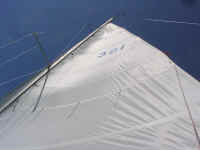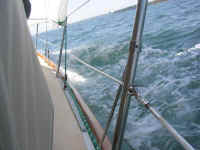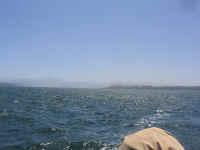 I
completed my day's work in the morning, and headed immediately out to
the boat, arriving at just after 1100. It was a beautiful day,
albeit slightly on the cool side. The winds were a bit stronger
than I had anticipated, registering 15+ apparent on my new wind
instruments at the mooring, so I decided to tuck in a single reef in the
main as I hoisted it, choosing to play it safe. It's always easier
to shake out a reef when sailing alone than it is to put one in, though
of course that is possible as well. I
completed my day's work in the morning, and headed immediately out to
the boat, arriving at just after 1100. It was a beautiful day,
albeit slightly on the cool side. The winds were a bit stronger
than I had anticipated, registering 15+ apparent on my new wind
instruments at the mooring, so I decided to tuck in a single reef in the
main as I hoisted it, choosing to play it safe. It's always easier
to shake out a reef when sailing alone than it is to put one in, though
of course that is possible as well. |
 With
a steady southeasterly wind of about 15-20 true (up to 24 apparent), I
had an excellent first sail, cruising down towards Portland Harbor--one
long tack--before turning and enjoying a screaming reach in the highest
winds of the day, back outside of Cow Island Ledge and then finally
turning round the northern tip of Clapboard. As I sailed past
Hussey Sound, the fog bank that I had noted lurking offshore earlier
began to blow in on the fresh seabreeze, oozing its way over and around
the islands and through the passes. With
a steady southeasterly wind of about 15-20 true (up to 24 apparent), I
had an excellent first sail, cruising down towards Portland Harbor--one
long tack--before turning and enjoying a screaming reach in the highest
winds of the day, back outside of Cow Island Ledge and then finally
turning round the northern tip of Clapboard. As I sailed past
Hussey Sound, the fog bank that I had noted lurking offshore earlier
began to blow in on the fresh seabreeze, oozing its way over and around
the islands and through the passes. |
|
 Though
the fog nipped at my transom, it never truly took over the inner bay,
and the day remained clear and bright. As I sailed towards the
mooring field, I rolled up the genoa and continued towards the mooring
under main alone, as I usually do. As I approached my mooring
ball, the wind gusted as strongly as ever during that afternoon.
My normal mooring-under-sail technique, which I use each time I sail to
the mooring--which is 99% of the time--is to approach from upwind of the
mooring, sailing downwind. I let the boom way out during the
approach as I weave between the nearby moorings and boats. Then, I
sail nearby to my mooring ball and continue past for a distance that
changes each time, depending on the wind speed, boat speed, and the
anticipated current. When I deem it to be correct, I turn the boat
sharply into the wind, which has the multiple effect of allowing the
mainsail--which was all the way out--to easily luff, as well as significantly
canceling the boat speed from the sharpness of the turn. When done
correctly, the boat usually maintains enough way to drift to the mooring
pendant, which I pick up easily. To enhance the dumping of air
from my sail, I release the boom vang as I make the turn, which raises
the boom and effectively prevents any wind from catching in the
sail. As soon as I have gotten a mooring line on the boat, I
return to the mast and lower the main. Though
the fog nipped at my transom, it never truly took over the inner bay,
and the day remained clear and bright. As I sailed towards the
mooring field, I rolled up the genoa and continued towards the mooring
under main alone, as I usually do. As I approached my mooring
ball, the wind gusted as strongly as ever during that afternoon.
My normal mooring-under-sail technique, which I use each time I sail to
the mooring--which is 99% of the time--is to approach from upwind of the
mooring, sailing downwind. I let the boom way out during the
approach as I weave between the nearby moorings and boats. Then, I
sail nearby to my mooring ball and continue past for a distance that
changes each time, depending on the wind speed, boat speed, and the
anticipated current. When I deem it to be correct, I turn the boat
sharply into the wind, which has the multiple effect of allowing the
mainsail--which was all the way out--to easily luff, as well as significantly
canceling the boat speed from the sharpness of the turn. When done
correctly, the boat usually maintains enough way to drift to the mooring
pendant, which I pick up easily. To enhance the dumping of air
from my sail, I release the boom vang as I make the turn, which raises
the boom and effectively prevents any wind from catching in the
sail. As soon as I have gotten a mooring line on the boat, I
return to the mast and lower the main.
This day, with the wind
quite strong, I misjudged my boat speed a tad--I had been going over 5
knots coming down--and made my turn just a bit earlier than I should
have. As a result, the boat did not slow down nearly as much as I
had expected, and completely slid by the mooring before I could grab
on. Oh well! No harm done--I simply resheeted the main and
came round for another pass, which ended up being nearly perfect, and I
grabbed the pendant easily. We all get a little rusty after 7
months on the hard!
|